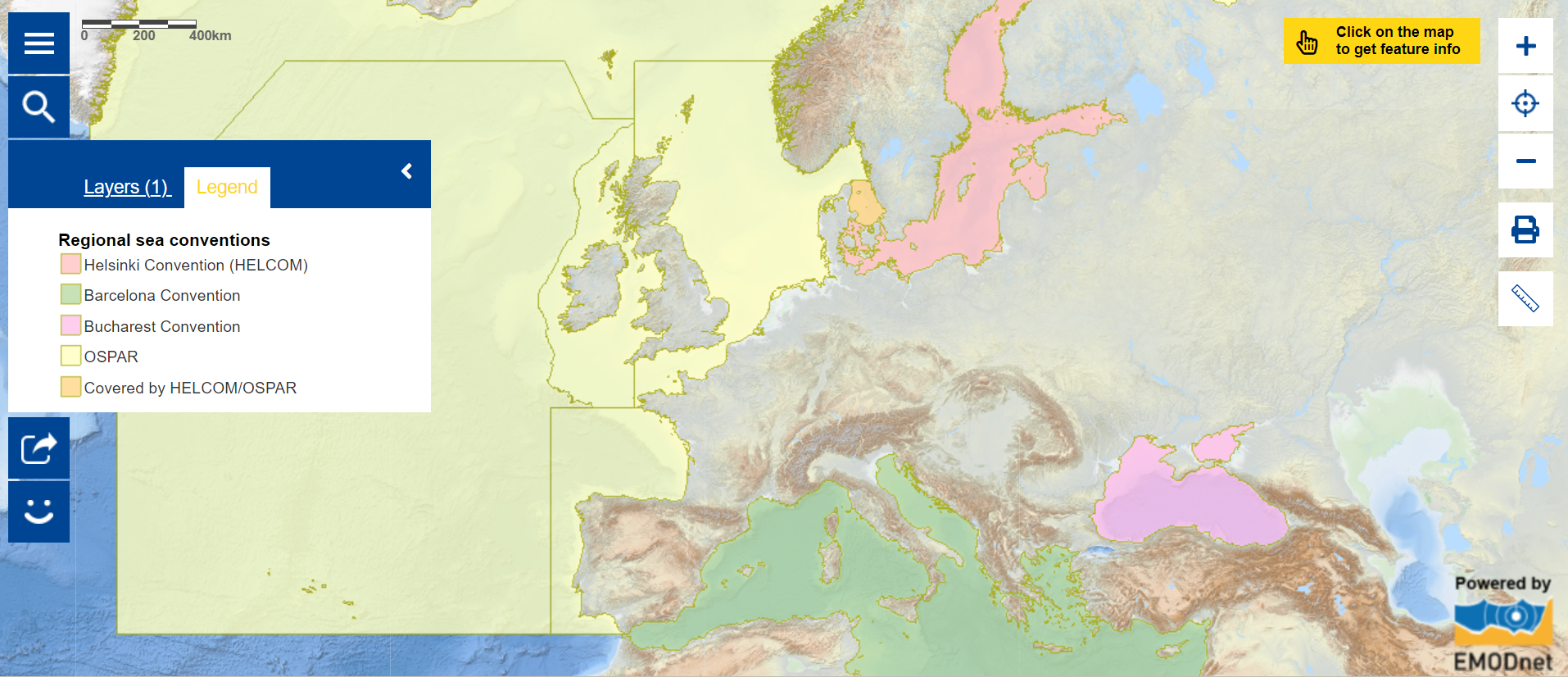
Tomorrow, 11 October 2024, the hybrid seminar ‘Sustainable agriculture for a healthy Baltic Sea’, organised by the Helsinki Convention (HELCOM) and the Embassy of Lithuania in Finland, will take place to celebrate the arrival of the “Save the Baltic Sea” expedition, winner of the 2023 EU4Ocean Challenge of the Year, in Helsinki (Finland). This event will explore how governments, scientists, policymakers, the agriculture industry, and citizens can collaborate to reduce pollution in the Baltic Sea, one of the world’s most polluted seas [1]. Presentations and a panel discussion will provide opportunities to address challenges due to eutrophication by exploring sustainable agricultural practices.
This week’s map highlights the four Regional Sea Conventions working to protect Europe’s marine environments through cooperation between European Member States (MS) and neighbouring countries. These conventions include the Helsinki Convention (HELCOM), Barcelona Convention (UNEP-MAP), Bucharest Convention (Black Sea Commission), and OSPAR Convention (OSPAR). Aligned with the European Union (EU)’s Marine Strategy Framework Directive (MSFD), these conventions promote sustainable seas and conserving ecosystems. Articles 6 and 8 of the MSFD refer to these conventions to develop strategies and assess marine conditions. Each convention has action plans addressing land- and sea-based pressures, maintaining biodiversity, and applying the ecosystem approach with objectives, targets, and monitoring indicators [2]. Click on the sea basins on the map to see more information about the conventions.
A key issue addressed by HELCOM in the Baltic Sea is eutrophication [3]. Over the past 50 years, eutrophication has become a major water quality issue. This process occurs when excess nutrients like nitrogen and phosphorus lead to an overgrowth of phytoplankton(microscopic marine algae). Indeed, plankton populations respond rapidly to changes in their environment, making them effective early warning indicators for detecting shifts in ocean conditions [5]. This leads to harmful algal blooms and oxygen depletion, which damage marine ecosystems and reduce biodiversity [4]. Agriculture, particularly livestock farming, is the main contributor to eutrophication. It is responsible for 94% of reduced nitrogen deposition [5]. Although all sea basins are concerned in Europe, it is a particularly important issue for the Baltic Sea. At least 97% of the Baltic Sea was assessed as eutrophic in 2011-2016 [6]. Therefore, HELCOM parties adopted the Baltic Sea Action Plan (2007, revised 2021) and the Baltic Sea Regional Nutrient Strategy (2021) to call for major reductions in farming nutrient inputs and measures to limit phosphorus and nitrogen losses [7]. Additionally, the EU’s Zero Pollution Plan aims to cut ecosystem areas at risk of eutrophication from nitrogen deposition by 25% by 2030. Finally, key initiatives such as the Farm to Fork Strategy and 2030 Biodiversity Plan also aim to address this issue [5] .
Wish to learn more?
- Learn more about the Save the Baltic Sea project and follow their route until the finish line!
- Watch WWF’s brief video exploring eutrophication challenges in the Baltic Sea;
- Read the Ocean Stewardship Coalition of the United Nations Global Compact’s Plankton Manifesto, calling for plankton-based solutions to address the triple planetary crises of biodiversity, climate and pollution;
- Watch the latest episode of the Euronews OCEAN Series to learn more about the Digital Twin of the Ocean, Europe’s game-changer for sustainable seas, where they discuss how artificial intelligence will tackle challenges around plankton;
- On 15 October 2024, attend the online European Maritime, Fisheries and Aquaculture Fund (EMFAF) 2024 Info Day on Smart specialisation for a sustainable blue economy and regenerative ocean farming. Register now to participate.
The data in this map are provided by the European Commission’s Directorate-General for Maritime Affairs and Fisheries (DG MARE).
[1] https://stateofthebalticsea.helcom.fi/
[2] https://water.europa.eu/marine/countries-and-regional-seas/regional-conventions
[3] https://helcom.fi/baltic-sea-trends/eutrophication/
[4] https://marine.copernicus.eu/explainers/phenomena-threats/eutrophication
[6] https://water.europa.eu/marine/europe-seas/pressures-impacts/nutrient
